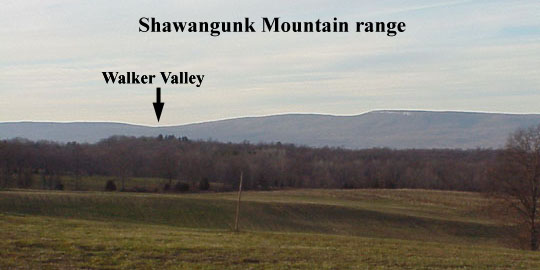
The Laser Beam AOP Encounter
15 January 2000
by Bruce Cornet, Ph.D.
Table of Contents
On 15 January 2000 Bruce Cornet and his wife Pat traveled from Red Bank, NJ, to Walker Valley, NY, for a dinner party, New Years Celebration with members of the United Friends Observer Society of Pine Bush, NY. The location was the Old Plank Inn on Rte 52 just north of the town of Walker Valley, which is nestled on top of Shawangunk Mountain (overlooking Pine Bush and the Wallkill River Valley to the south).

Cornet wanted to see old friends and learn the latest news regarding AOP sightings and paranormal phenomena observed by locals in the area. After a two year lull in AOP activity, many of the people who attended said that they had either seen something themselves or heard of other people in the area who had witnessed AOP during the last couple months. As one couple put it, "All hell has broken loose on our property." One dinner guest said that she and her boyfriend were paced by a light on their trip up to Walker Valley. When she viewed the video Cornet had taken of an AOP which had paced his car, she said that the same thing had happened to them. Unfortunately, they did not record it on video, so a comparison cannot be made.
Skeptics get it wrong: People who have alien sightings weren't drinking before they had their sighting.....
|
The AOP which Cornet recorded occurred on the same stretch of Rte 208 just south of Walden, NY. Not much further south Cornet had recorded an AOP performance on 18 December 1999, which is the subject of "It's Happening Again!" He and his wife were surprised by not one, but two AOP which came out of nowhere to fly over them. The first one was spotted at Scotts Corner when Cornet crossed Rte 17K. It flew over their car from behind, slowed down to their speed, and paced them for a short distance. It had a solid white light with a red pulsing light to the right. It made no sound.
As Cornet turned on his camcorder, he noticed another light off to the left, which was headed in the same direction. As soon as he raised his camcorder, AOP#1 moved off to the right and disappeared from view behind a hill. He turned his camera towards AOP#2 and recorded a continuous sequence of events up to the time it flew over his car, which by that time was stopped along side the road.
What distinguishes this sighting from all others Cornet has photographed or videotaped is the use of a red laser by the AOP. It was not noticed until the videotape was replayed at the Old Plank Inn. Others at the dinner party noticed the reflection of a red light dancing on the side window of his car as he recorded the approach of the AOP. At the time he dismissed it as a reflection of some light in the car, but upon studying the video he realized it was a tracking laser which had been aimed at his car. That can be determined by the movement of the laser reflection with the movement of the AOP, ruling out a stationary light inside the parked car or by the road.
Cornet recalled seeing something red reflecting off his left shoulder in his peripheral vision, but did not turn to check it out. Therefore, he cannot confirm that it was the laser light. However, whatever it was, he felt warmth through his dark brown leather jacket.
The AOP also put on a light show of flashing blue-green (blue and green), red, and white lights as it made its approach. Even yellow and purple lights can be seen on the video. The lighting pattern of the AOP was unlike that of any conventional aircraft or helicopter, because the flashing blue-green light was on top, which alternately flashed red, while another red light flashed on its starboard side, a second white light flashed on its port side, and a third white light flashed below the large white light(s), which defined the center of the AOP. Pilots know that red navigation lights are never positioned on the starboard (right wing) side of an aircraft - only on the port (left wing) side, while green lights are always positioned on the starboard side, and never on top of the aircraft.
|
|
If you are still interested in learning more about this unusual sighting, please continue reading below. Animations can be found in the Materials and Methods section.
Date: 15 January 2000.
Time: 6:19:04 - 6:20:16 pm EST.
Location: AOP#1, Rte 208 at Scotts Corner in front of car, below 1,000 feet. AOP#2, Rte 208 1.5 miles south of Walden, NY; observed from east side of road (red asterisk on map below) after being paced for about 2,000 feet along Rte 208 after AOP#1 departed.
Weather: Good visibility with a high ceiling of clouds; air temperature about 30 degrees Fahrenheit or less. Moon at 50 degrees southeast - half disc.
Astronomy: Mars at 31 degrees southwest, Uranus at 12 degrees southwest in direction of observed AOP, but not visible due to clouds; Neptune, Mercury, Venus, and the Sun all below horizon.
Witnesses: Bruce Cornet and Patricia Huff-Cornet.
Car: White 1995 Chrysler Cirrus.
Sound produced by AOP: None - silent.
Camcorder: Sony Handycam video Hi8, model CCD-TRV81 (3-971-670-0).
Medium: Sony Hi8 MP 8mm videotape, 60 minute.
Duration of video containing AOP: 76 seconds.
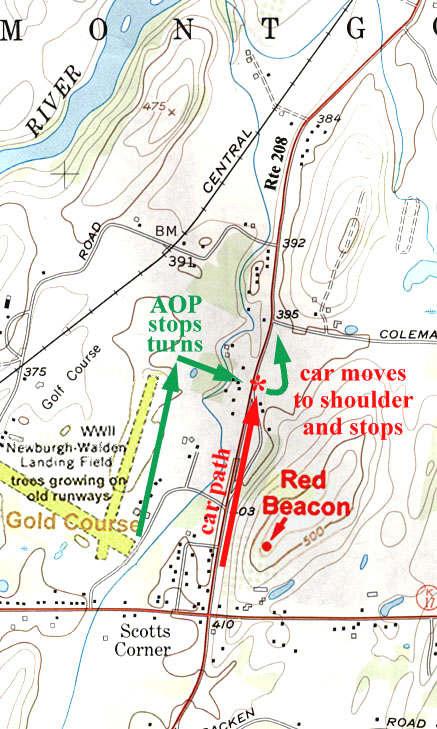
The sighting was recorded on 76 seconds of 8mm videotape, and analyzed frame by frame, with selected frames being transferred to a computer using GrabIT peripheral hardware (Aimes-Lab). Three animated gifs were constructed using those frames: crosaop2 used 35 frames, crossaop4 used 27 frames, and crosaop8 used 39 frames. Except when editing involved slow motion effects or labels (requiring longer pause times for readability), the timing of frames was adjusted to pseudo-real time or according to the second notation on each frame. If five frames were used for a given second of video time, each frame was given 1/20th of a second on the gif, if ten frames, 1/10th of a second each, etc. Because animated gifs operate (run) differently on different computers and with different web browsers, play time for each animated gif may not be actual time. Observe the seconds time notation on the video time for a sense of real time.
Because each frame was reduced to 25% of its original 720 x 480 pixel size, the compression algorithm averaged brightness for adjacent pixels, thereby reducing the true brightness of the AOP lights. In order to compensate for this reduction in intensity, a single white or lighter-colored pixel was substituted for the brightest central pixel in each light once the frames had been size reduced (to 180 x 120 pixels, 300 x 300 dpi resolution). This was done so that the lights would appear close to their brightness on the original video. Each image was re-centered on the gif frame by moving a large block of pixels. This was done in order to remove the effects of camera movement and to show AOP movement as it was observed. In the third or last animated gif additional adjustments were made in image position so that the relationship between tracking position of the laser reflection on the window and AOP position can be followed. All moment flashes of lights are included in the animations.
The video frames had to be reduced due to their original large size, which produced a gif in the 5-6 megabyte range. Gifs using frames half that size were in the 2-3 megabyte range. The final gif size for this website is 160K to 218K, which produces a satisfactory download time but limits resolution. Individual frames close to original size and resolution are provided to make up for that loss in quality.
Animated gifs from video (in sequence from left to right).
|
|
|
AOP slows as car slows. Cornet activates the right directional signal. AOP stops and makes a sharp right turn towards the car (seen in video when one light briefly changes to two closely spaced lights). As it approaches the car a red dot or reflection appears on the side window. At first the light is in the upper left corner of the video (image #1), but drops in position as the AOP moves towards the car (images #2 - #6 below). In image #1 the laser color appears purple, but this is probably due to a frame edge color change during digital transfer. The laser reflection disappears when the window is lowered at 6:20:10 seconds, proving that the light is a reflection and that it is associated with the AOP. It was not present after the window was raised back up, which it would have been had it come from a light on the car. Note the unusual lighting pattern and color changes of the lights in the enlargements (insets).
Individual frames and enlargements.

If this had been a conventional helicopter, when its strobes fired, they should have illuminated the rotar blades as in the images below. But at no time does the video capture any reflection off of rotar blades.
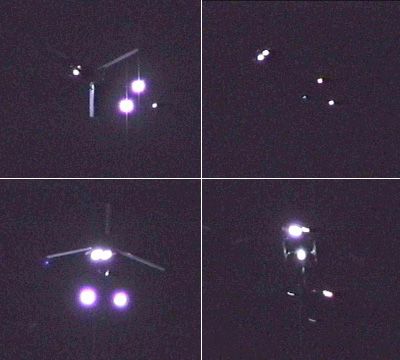
As the window pane drops below the laser beam, the curved top of the window catches the beam's last reflection. Instead of the reflection spreading out as the street light does (white arrow) or moving along the angled window edge, it remained focussed and unchanged in position.
Disappearance of laser reflection.
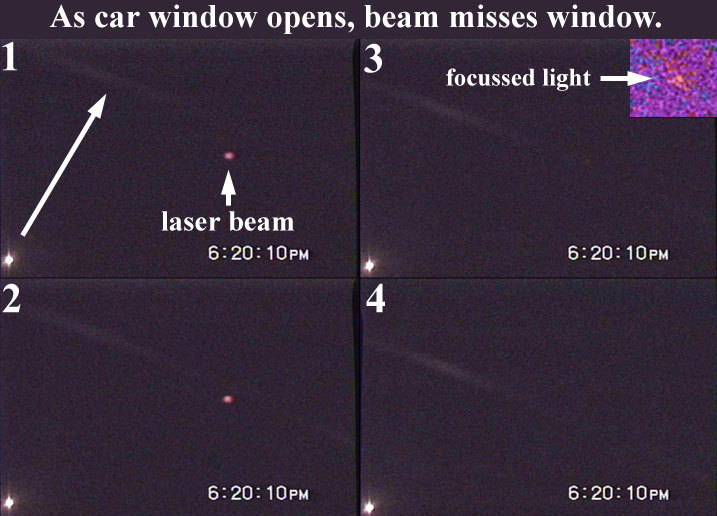
For comparison, a ruby light beam from a laser pointer was pointed at the window of the car at the same angle and photographed with a digital camera from within the car. The simulation produced an identical round reflection on the window, which moved with the laser beam. The only difference was color, which is dependent on how monochromatic and coherent the laser beam is.
Reproduction of laser reflection on window.
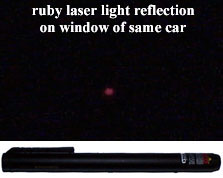
In order to rule out a reflection from some light within the car, the colors on the instrument panel and radio were examined. Only one light in the car produced a red reflection like the ruby laser beam. That was a small red security light on the left side of the dashboard. The security light comes on only when the car is turned off (the car was stopped but still running), and it flashes. The reflection in the window did not flash, but remained solid.
Car instrument lights and dial colors.
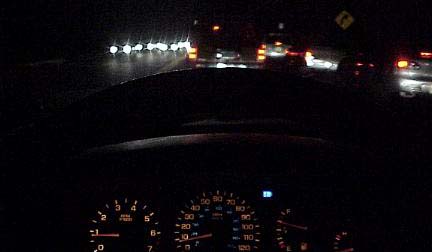
A friend was concerned that I might be jumping to conclusions about the red light being evidence of a laser hit, because neither my wife nor I saw a laser light dancing around inside the car. He also thought the laser light should have hit my face and head. This is my response.
Thanks for the alternative viewpoint. I appreciate your caution. But you must keep in mind that I was looking through the B&W viewfinder during most of the approach. The beam would have been angled just to the left side of my head, and most of my face would have been blocked by the camcorder. It would not have been visible to Pat, because I was in her way. It all happened in a matter of only 6 second (from first indication of a red dot in video to the time it is no longer visible after window dropped). Once the window was down I stuck my head, shoulders, arms, and camcorder out the window to get a better shot of the AOP. I never looked backwards. I was able to get only four more seconds of video before the AOP flew over the car and I lost sight of it.I do recall seeing something red reflecting off my left shoulder in my peripheral vision, but did not turn to check it out. Therefore, I cannot confirm that it was the laser light. However, whatever it was, I felt warmth through my dark brown leather jacket. I clearly remember that.
It was a simple experiment to duplicate the conditions using my ruby laser pointer. From the angle of the approaching AOP, the laser beam would not have been seen by Pat, because the hit spot would have been in front of me and I had my back turned towards her. Remember, the angle of beam descent would have varied from 26 degrees (estimate 1,000 ft. elevation at 2,000 ft. distance) to 60+ degrees as it got close to the car. The beam reflection on the window was approximately centered on the window (i.e. at eye level). Thus, it was angled downwards from that point. In the simulation the beam hit my left shoulder and chest.The friend then asked if I had taken into consideration the red light on the front of the camcorder. I had never seen that light reflected back from a window, and therefore did not suspect it. But when I checked, I realized that the round red dot on the window could not have been the red light on the camcorder. That is because the camcorder light is rectangular in shape (see below).
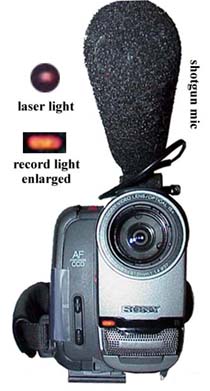
My friend also wanted to know how close the camcorder was held to the window, which is important from a focal standpoint. If the camera lens was too close to the window, any reflection on the window would be out of focus. In front of the camcorder is mounted a shotgun mic, which limits the minimum distance the camera could have been from the window to 5.5 inches (14 cm). At that distance, the reflection would be visible even though slightly out of focus (implied by the fuzzy margin to the red dot, compared above).
All of the points discussed above must be taken into consideration whenever doing a thorough investigation. For those who want to investigate AOP, you also need to be as thorough in your investigations. Make as few assumptions as possible, and always be ready to test new theories and ideas.
Without additional sensor data (for example, spectroradiometry) there will always be skeptics who doubt that what I videotaped was in fact a laser tracking beam. It is important for AOP investigators to realize that they must use the latest technologies available in order to eliminate alternative explanations. If I had had a night vision attachment on my camcorder, there would be little doubt regarding the shape of the AOP. It is necessary to bring as much data possible to the subject in order to extricate the truth from uncertainty. I hope to soon have night vision equipment on my camera, cost permitting, so that uncertainties can be reduced or eliminated.
Above any consideration of why a visible red laser would be used on a civilian target by a military or police unit one must consider what that AOP was doing there that night at that precise time Cornet and his wife passed. If this had been an isolated incident, one could dismiss it as perhaps a police helicopter looking for a suspect. But the police don't use lasers for tracking cars (they do use night vision equipment, however). NY State Police told me that they do not carry weapons in helicopters (which could have laser targeting capability), and that shooting a laser at a driver on the road is against the law (it could blind the driver and cause an accident).
Wayne (ret) US Army Reserve wrote in and said: "Hi! I spent quite a number of years in the Army Reserve and Army National Guard. Police always have a sidearm, even their helicopter pilots. There have been a number occasions, special or not, where they will carry rifles, shotguns, etc. It is a FACT that a laser pointing device can be mounted on ANY gun, from handgun on up! My own experiences in active military found us on more than one occasion looking for escaped federal prisoners from a helicopter with federal police armed with scoped rifles in our helicopter (doors open and occupants strapped in). In other words, police or military will not admit to you or anyone else what they carry or do."
Lasers are used in military weapons targeting, but they are infrared lasers, which do not produce a visible reflection to the naked eye. An IR laser beam will be picked up by a digital or CCD camera because of the sensitivity of the CCD chip to infrared light (Thanks to a reader who wrote in, and who has experimented with infrared lasers). FAA regulations do not specifically address the use of active tracking equipment other than radar. Military helicopters at Stewart International Airport are used only for transporting personnel to West Point and back.
Laser rangefinder binoculars have an effective distance range of 400 yards, while a targeting laser on a handgun or rifle can be seen up to 1,000 yards away in subdued lighting conditions (or at night). From T to golf flag is a distance of about 180 yards.
Commercial Laser Rangefinders
Q. How far will the Yardage Pro range?
Why can't I range to a deer 400 yards away or why can I not range to the golf pin at 304
yards?
A. These are excellent questions and probably by far our most frequently
asked questions. Unfortunately, a quick answer cannot be given.
First, let me explain the numbering scheme. The 400 in the name means the range finder will range to trees at 400 yards away. Trees are neither the best nor the worst targets for range finding.
There are many variables that contribute to the ranging performance:
Realistically, you should expect to range to a deer no further than 275-300 yards with the Yardage Pro 400. A limp golf flag ranges only about 180 yards. Believe it or not, as you use your range finder more and more, you will learn subtle tricks to help you range further. You want to know some tricks? Well okay, here goes:
Q. Are the range finders eye safe?
A. Absolutely, both the Yardage Pro 400 and 800 are well within the eye safety
limits established by the FDA for Class I laser products. In fact, Bushnell considers eye
safety so important that we test laser output power with the largest aperture (50mm)
allowed by the FDA. Some laser manufacturers use a 7mm aperture to test the output power.
Obviously, if the transmitter aperture is bigger than 7mm, only a percentage of the output
power is collected in the 7mm aperture. If Bushnell tested its laser products with a 7mm
aperture, only about 3% of the total power would be collected. We are very concerned with
public safety and test only with the most conservative methods. Bear in mind that the CFR
regulation allows the 7mm testing, it is up to the individual manufacturer to determine
how safe his device will be. The testing with the 50 mm aperture allows the use of
focusing optics around the range finder without fear of eye safety.
| The "Cross Hair" version offers a standard bright laser dot or a cross hair. A simple flip of a switch gives you the benefit of two laser sights in one! | ||
| The "Bullseye" version offers the choice between the standard bright dot or a bullseye" |
Range :
Up to 1000 yards in subdued light conditions.The laser reflection on the window of the car first occurred when the AOP was at least 500 yards (1,500 feet) from the car. The AOP could have been as much as 700 yards away when it made its turn towards our car.
Keeping the laser on target from that distance is difficult if the device using the laser is hand held (see above manufacturer specs and conditions). One can see movement of the red dot on the window, but it moves much less than could be accomplished by someone holding the laser in a moving object. A pen laser is difficult to keep on target from only 30 feet away. If that had been a helicopter, there would have been considerable vibration with bumps, which would have caused any handheld laser to be jolted well off target more than once. The fact that the dot remains so steady or relatively fixed on the window indicates the use of probable computer tracking, which had to be controlled by some other type of targeting system, such as radar or an infrared optical system.
Without additional sensor data (for example, spectroradiometry data), there will always be doubt by some skeptics that what I videotaped was in fact a laser tracking beam. Any additional data would help eliminate alternative explanations, and help extricate the truth from uncertainty. That is why AOP investigators must consider acquiring the latest surveillance technology available. A night vision attachment to my camcorder would have left little doubt about what was seen.
For anyone who has been paced or followed by a helicopter, it can be an unnerving experience if you don't know why you are under surveillance. And if you do know why you are under surveillance, it can be even more unnerving.
Whatever was tracking us that evening was not a police helicopter or military helicopter according to local authorities. I was not a fixed-wing aircraft, because it could stop in midair and turn from a hovering position. It also did not make any audible noise, which any normal (non-stealth) aircraft would have made.
Its lighting was highly unconventional for an airplane or
helicopter. The top light alternately flashed red and a
non-standard green (more of blue-green
color). An alternating red and green
light-gun-signal from an airport tower means "exercise extreme caution."
In addition, there were no standard nighttime hazard lights on the AOP, which means that
it was flying without FAA approval. And finally, the AOP flashed a pattern of lights
in the form of a crude cross ![]() . It flashed the same pattern twice just
before it flew over the car and beyond the range of the camera. Even when it was
closest to the camera, no fuselage was visible. All that is visible on the video is
a refracting noise pattern around the lights, implying that it was a solid object, but had
some sort of visual shielding (stealth) about it.
. It flashed the same pattern twice just
before it flew over the car and beyond the range of the camera. Even when it was
closest to the camera, no fuselage was visible. All that is visible on the video is
a refracting noise pattern around the lights, implying that it was a solid object, but had
some sort of visual shielding (stealth) about it.
What could all of this mean?
Skeptic's Corner |
Review of Evidence |
| The light was a star low on the horizon and created an illusion that it was pacing your car. | No bright stars (magnitude 1.0 or less) were visible in that area of the sky (or on star charts) and high clouds obscured most stars. |
| It was a plane that turned towards the camera, and therefore seemed to stop in midair. | It did turn, but not before slowing to a stop. In one video frame the AOP changed direction from north to east, making what appears to be a 90 degree turn without banking. |
| It was a helicopter, which can stop and hover. | It could have been a helicopter, but it did not have FAA approved running lights, its lights contained colors which are not used on aircraft, such as blue and purple, and it made no sound. |
| It was a military helicopter with sound abatement technology. | It could have been a military helicopter, but Stewart Airport authorities said that the only helicopters owned by the military at that airport were used for passenger transport, not for tactical surveillance. Only one medical helicopter operates out of Orange County Airport three miles to the southwest. |
| Because it was military its lighting did not have to conform to FAA requirements. | Even the military has to follow standard navigation lighting at night when not in combat, and the night light pattern on the AOP was anything but standard. |
| It was a police helicopter searching for suspects. | Police helicopters do not have sound abatement technology, do have standard night lights, and do not track suspects using computer-assisted laser rangefinders. Only the military does that. |
| It was not a laser reflection in the window, because you did not see the light reflecting on anything in the car. | I recall seeing (peripheral vision) a red reflection and feeling warmth on my left shoulder and chest, but did not turn to check it out. Because the red dot follows AOP movements precisely, it could not have been caused by a stationary light in the car or on the ground. |
| You must be mistaken. Anecdotes are not evidence. | Videos are evidence, however, and everything that was described can be seen happening in the video. |
| I don't believe it. It must be a hoax. | You are entitled to your own beliefs. Beliefs are not facts. Denial and excuses will not change the facts. |
Several interpretations can be made from the data:
1) It was not a conventional aircraft or helicopter.
2) The pilot was looking for someone, because the AOP tracked (paced) our car before flying over us after we stopped.
3) The patterns of lights and colors the AOP produced after it turned towards us, including the pattern of a cross right after the window opened, implies that the pilot was intentionally signaling us.
4) The use of a laser beam followed by the light cross implies that Cornet was the intended target (as opposed to his wife or someone else on the ground).
5) Someone with unconventional technology was able to find Cornet at night, which implies either a very sophisticated surveillance system or that the pilot was able to find his car through a bug or implant.
Was this AOP event a warning, and/or did it mean: We've got your number? Did the alternately flashing blue-green and red light indicate
""?
What would you do if this happened to you?
Copyright B. Cornet 2000
Date this web page was last modified:
03/21/22